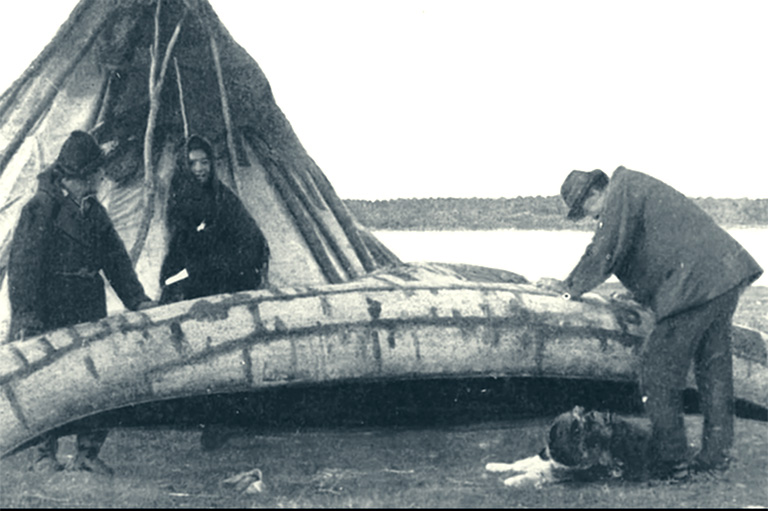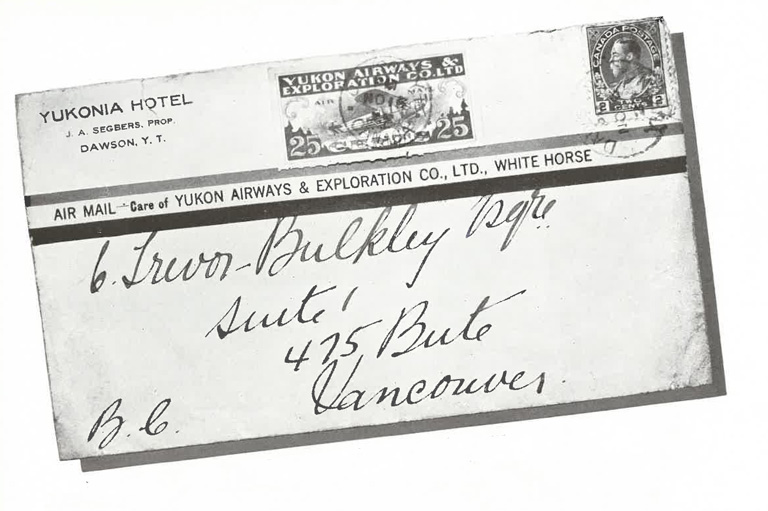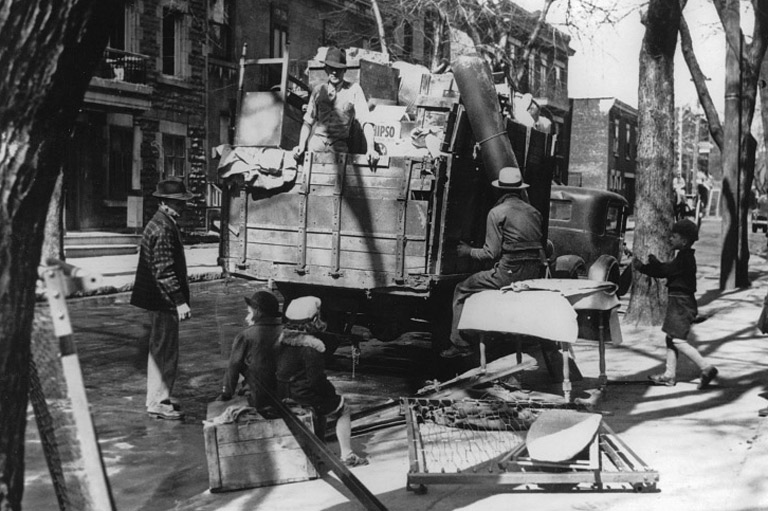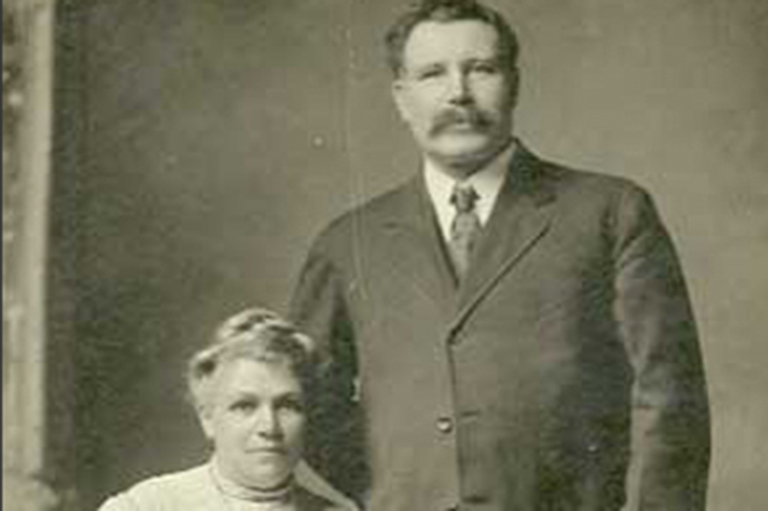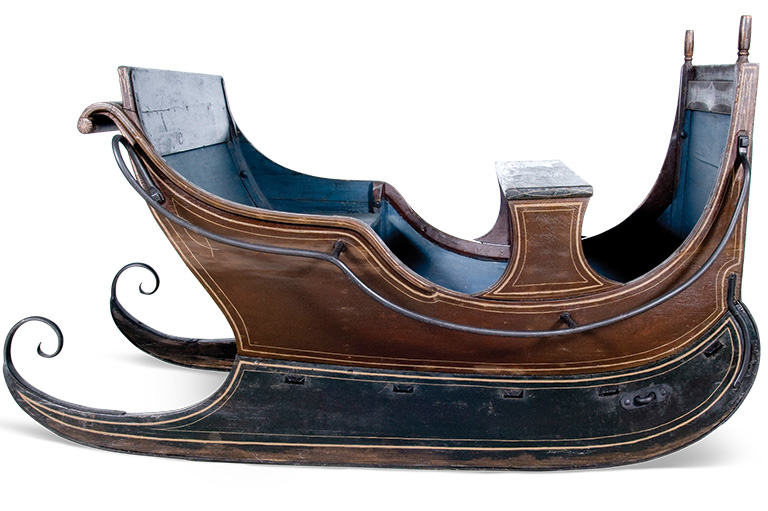Discover a wealth of interesting, entertaining and informative stories in each issue, delivered to you six times per year.
Bluenose II Reborn
Click here to skip to the end and watch the video.
From the wharf, the sleek black hull, the long sweep of the bow, and the soaring masts and rigging all looked as shipshape as ever. Inside the belly of one of the world’s iconic sailing vessels, though, it was a much different story.
By the time Alan Hutchinson got a close look below the deck of Bluenose II in the summer of 2009, the ship was more than forty-five years old and decades beyond its best-before date. Salt water was penetrating the hull from below. Rainwater had seeped in from above. Rot and decay were eating away at the planking and the elegantly curved ribs. Hogging — the boat builder’s term for the gradual sagging of an aging vessel’s frame — had dropped the stern of Nova Scotia’s trademark schooner by more than a metre.
Article continues below...
-
 The new Bluenose II with a fresh coat of paint.Nova Scotia Archives
The new Bluenose II with a fresh coat of paint.Nova Scotia Archives -
 The original Bluenose sails close-hauled during her first racing series in 1921.Nova Scotia Archives/W.R. Macaskill
The original Bluenose sails close-hauled during her first racing series in 1921.Nova Scotia Archives/W.R. Macaskill -
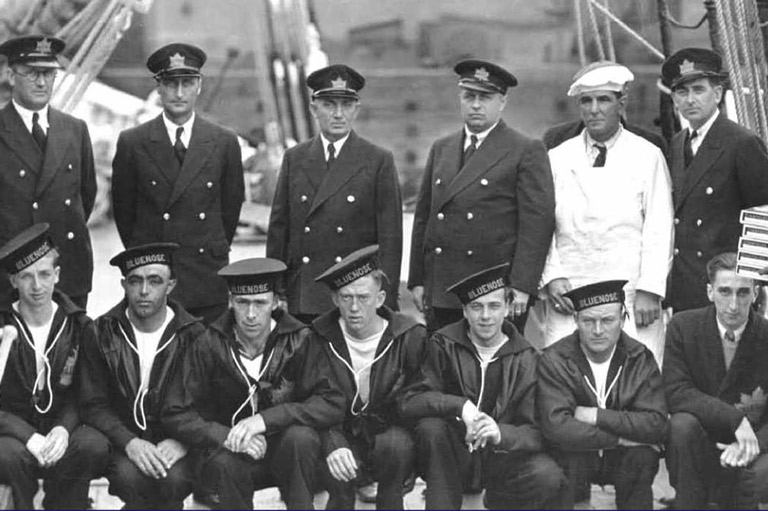 Captain Angus Walters (back row, third from left) and crew pose on the deck of the Bluenose in this undated photo.Nova Scotia Archives
Captain Angus Walters (back row, third from left) and crew pose on the deck of the Bluenose in this undated photo.Nova Scotia Archives -
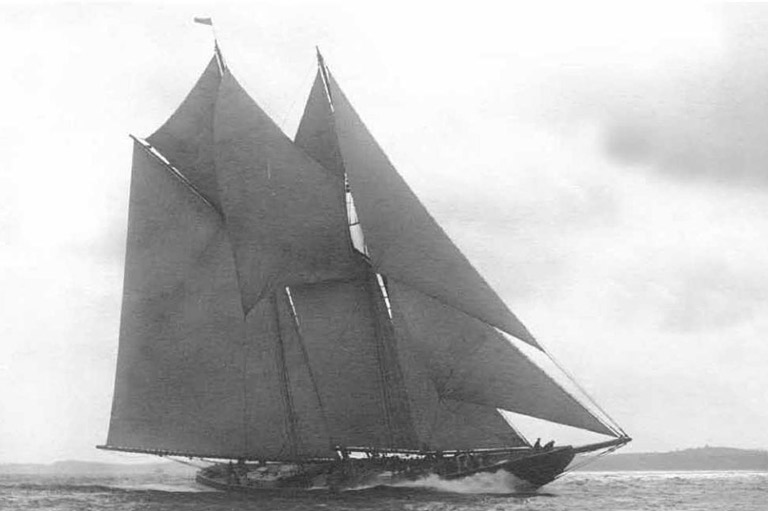 Bluenose crosses the finish line to win the 1931 International Fishermen’s Trophy series and defend the championship against the Gertrude L. Thebaud.Nova Scotia Archives
Bluenose crosses the finish line to win the 1931 International Fishermen’s Trophy series and defend the championship against the Gertrude L. Thebaud.Nova Scotia Archives -
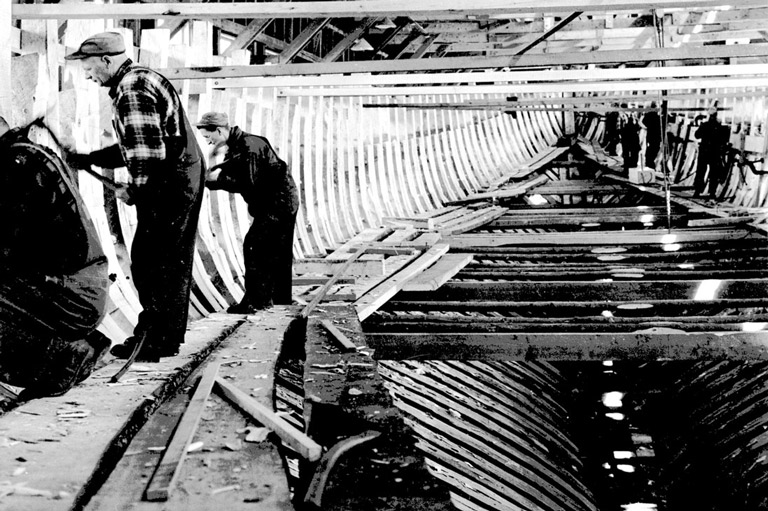 Men work on the inside of the hull of Bluenose II at Lunenburg, Nova Scotia, 1963.Nova Scotia Archives
Men work on the inside of the hull of Bluenose II at Lunenburg, Nova Scotia, 1963.Nova Scotia Archives -
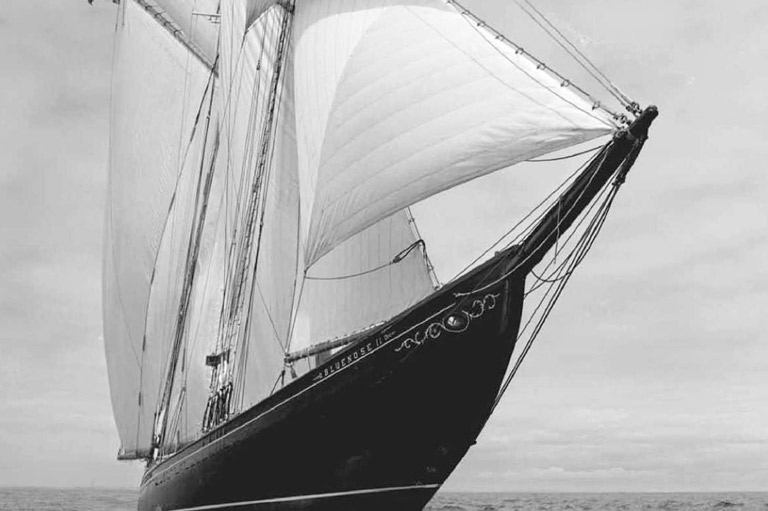 Bluenose II in full sail in 1969.Nova Scotia Archives
Bluenose II in full sail in 1969.Nova Scotia Archives -
 Workers place a plank into position during the refurbishing of the Bluenose II.Nova Scotia Archives
Workers place a plank into position during the refurbishing of the Bluenose II.Nova Scotia Archives -
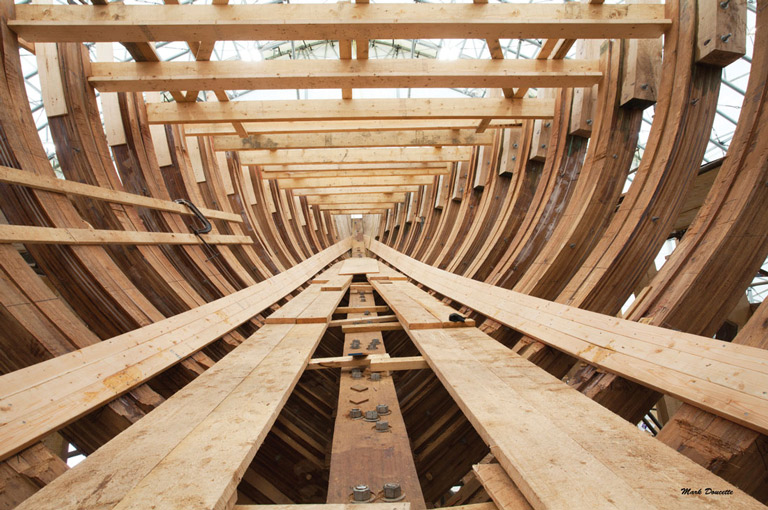 The refurbished Bluenose II's interior sheathing begins to take shapeMark Doucette
The refurbished Bluenose II's interior sheathing begins to take shapeMark Doucette
“A lot of the lower sections of the frames and planks were in pretty rough shape,” recalled Hutchinson, the president of Covey Island Boatworks of Lunenburg, Nova Scotia.
The vessel’s owner, the government of Nova Scotia, faced a tough decision. It could patch up the worst of the damage, as had been done many times before. Or it could invest the millions of dollars needed to keep Bluenose II sailing into the next half of the twenty-first century.
The province charted the latter course in what proved to be a costly, problem-plagued project. Hutchinson’s company, which builds luxury yachts, joined forces with two other firms — Lunenburg Industrial Foundry and Engineering and Snyder’s Shipyard — to form the Lunenburg Shipyard Alliance and build a modern Bluenose II. The new ship would be true to its heritage as a replica of the fastest of the Grand Banks racing schooners.
“Bluenose II is a tangible connection to our past,” said Bill Greenlaw, Nova Scotia’s executive director of archives, museums, and libraries and the government’s lead official on a refit to see the schooner back in the water and under sail.
The story of the Canadian schooner that outraced the Americans has become the stuff of legend and a source of national pride, a symbol of triumph over adversity. Canada is not a country known for celebrating its heroes, but there’s something different about the swiftness, grace, and indomitable spirit of the original Bluenose. It has glided across Canada’s ten-cent piece since 1937, and its sails have billowed on three postage stamps. Folksinger Stan Rogers and other songwriters have sung its praises. Countless writers and journalists have retold its David-and-Goliath story.
“It was one of the rare occasions in which, in an absolutely fair and square contest, we beat the Yanks repeatedly,” said Nova Scotia writer Silver Donald Cameron, who contributed his own volume — Schooner: Bluenose and Bluenose II — to the shelf of Bluenose books.
The schooner was launched in Lunenburg in 1921 with one goal in mind — to win back the International Fishermen’s Trophy that had been lost, the previous year, to the rival Massachusetts fishing port of Gloucester. A group of Halifax businessmen led by William H. Dennis, a senator and the publisher of the Halifax Herald, offered the trophy after an America’s Cup race was called off due to high winds any fishing schooner could have handled with ease. Theirs would be a competition between working schooners and real sailors, not the timid crews of rich men’s yachts.
After the embarrassing defeat of Nova Scotia’s first challenger in 1920, an amateur naval architect, William J. Roue, was commissioned to design Bluenose. Measuring 143 feet from bow to stern and with masts as high as a twelve-storey building, it was dispatched to the Grand Banks to fish for cod — a prerequisite for vessels competing for the trophy. An experienced Lunenburg fishing captain, Angus Walters, signed on as majority owner and skipper.
Bluenose won the trophy in 1921 and defended it in 1922, outclassing the best schooners the Americans could muster. A rematch in 1923 was cut short when Walters, incensed by a ruling that he had strayed from the course, refused to continue racing. The dispute ended the competition for the rest of the decade, and Bluenose fished out of its home port, Lunenburg. In 1930, Walters finally agreed to race against a speedy new addition to the Gloucester fleet, Gertrude L. Thebaud, for the newly created Lipton Cup. Bluenose lost.
It was the first and last time the schooner was defeated in an international racing series. The following year, Bluenose and Thebaud squared off for the Fishermen’s Trophy, and this time Bluenose emerged the victor. As the Great Depression deepened, the now-famous schooner represented Canada at the Chicago World’s Fair in 1933 and crossed the Atlantic two years later to help celebrate King George V’s silver jubilee. “Her name,” noted Toronto’s Evening Telegram, “is a household word. She has knit Canada together.”
A final showdown came in 1938. Old, waterlogged, and worn out from too many seasons on the Grand Banks, Bluenose somehow beat the odds and defeated Thebaud three races to two while setting a speed record.
“There’s something about the incredible drama of that, of defending the championship,” said Cameron. “It’s the last time she’s ever going to sail in a race, and she reaches deep inside herself and finds whatever it takes to win.”
It was a last hurrah for the vanished age of wooden ships and iron men — and for Bluenose itself. Unable to drum up interest in preserving his beloved schooner, Walters was forced to sell it in 1942 and retired from seafaring to run a dairy. Bluenose ended its days in the Caribbean, ferrying cargoes of fruit and rum until it sank on a reef off Haiti in 1946.
A legend was born of the unbeatable Bluenose, even though it lost its share of individual races and the 1930 Lipton Cup series. “She was beaten often enough,” said author Marq de Villiers, who recounted the schooner’s exploits in his 2007 book, Witch in the Wind. “You can be a World Series baseball team but you’re still going to lose games.”
Bluenose was fast, especially in strong winds — a Canadian warship escorting it to Gloucester had to do fourteen knots to keep up — and theories abound about the source of its speed. Many credit Roue’s streamlined design or Walter’s decision to add height to the bow during construction. One Lunenburg shipwright was convinced a frost during construction had “set her beams ... like no man could ever do.” De Villiers is among those who credit a perfect combination of sturdy vessel and skilled captain. Walters, he said, was at the helm for so long under so many conditions that he could sense how far he could strain sails and rigging in the quest for speed. “He got to know every quirk, every possibility.”
For all the racing victories, perhaps the finest hour for Walters and Bluenose came during a fishing trip in April 1926, when a powerful blizzard caught the schooner at anchor off Sable Island, the infamous graveyard of unlucky ships. Walters lashed himself to the wheel and battled for eight hours to keep from running aground as the crew huddled below, waiting for the end. Bluenose kept “biting her way into the gale,” Walters recalled. “Don’t know as any other vessel could have done it. All you could do was to keep her going and hang on.”
The Bluenose saga almost ended that night. “If it wasn’t for the ship she was and the captain he was,” crew member Clement Hiltz told a reunion of Bluenose crewmen decades later, “I wouldn’t be here today.”
It took Hollywood’s quest for authenticity and history’s most notorious mutiny to bring Bluenose back to life.
In the early 1960s, MGM Studios commissioned Smith & Rhuland, the shipyard that built Bluenose, to construct a replica of HMS Bounty for the movie Mutiny on the Bounty. (The same replica was in the news in the fall of 2012 when it sank in a hurricane off North Carolina with the loss of two crew members.) If Lunenburg shipwrights still had the skills to build large wooden sailing vessels, some said, why not rebuild the fabled Bluenose?
Halifax’s wealthy, brewery-owning Oland family came forward, paying more than a quarter of a million dollars — a fortune at the time — to build a schooner based on Roue’s original plans. Gerald Zwicker, then in his early twenties, worked on both ships and remembers manhandling massive rib timbers for a little more than a dollar an hour. “It was hard work because everything was heavy,” he remembered, but “it gave you a good feeling to know that you could help build something like that.”
Launched in 1963, Bluenose II was used to advertise Oland’s Schooner brand beer and showcased Nova Scotia’s maritime heritage at Expo 67 in Montreal. In 1971, the government assumed ownership and launched the vessel on a new career as the province’s star tourist attraction. When not at dockside in Lunenburg or Halifax, or taking visitors on harbour cruises, it joined parades of tall ships and visited ports along the Eastern Seaboard and the Great Lakes. It ventured through the Panama Canal to attend the 1986 world’s fair in Vancouver. Its elegant lines and distinctive triangular sails became a magnet for crowds. During one visit to Toronto an estimated 100,000 people walked its decks in a matter of days.
”It’s one of the things that distinguishes Nova Scotia,” said Cameron, who was aboard Bluenose II for a 1983 trip to Atlantic City. “It is the symbol of Nova Scotia.”
Bluenose — or Bluenoser — has been a nickname for Nova Scotians since the late eighteenth century, and there’s no escaping the schooner in its home province. Its logo separates the letters and numbers stamped on every blue-and-white Nova Scotia licence plate. More than two hundred and fifty Nova Scotia companies and community groups, past and present, have adopted the name, from Bluenose Accounting and Tax Services to Bluenose Well Drilling Ltd.
It is also a symbol of a simpler age, a prosperous time when wooden ships were built in harbours and coves throughout the Maritime provinces, fishing was the region’s lifeblood, and Nova Scotia’s ships and sailors could be found in ports around the world. Bluenose II evokes nostalgia for “a province that was self-sufficient and confident and made its own way in the world,” said de Villiers.
Historians Ian McKay and Robin Bates have challenged this romanticized, packaged-for-tourists view of Nova Scotia’s history. “Bluenose provided a record of stalwart heroes, the rugged individuals of a maritime frontier,” fostering an escapist image of a “proud people with a noble past,” they wrote in their 2010 book, In the Province of History.
A reminder of the harsh reality of Bluenose’s lost world can be found on Lunenburg’s waterfront, amid the centuries-old architecture that has made this South Shore town of 2,300 a UNESCO World Heritage Site. A circle of black-granite pillars, configured as a compass rose, bears the names of hundreds of local sailors and fishermen who have perished at sea since 1890. Bluenose is listed among the close to ninety vessels sunk over the years, and forty more are recorded as lost with all hands.
”It was a brutal way of life,” said de Villiers. The crewmen of Grand Banks schooners fished cod from small dories, often in “weather that was very close to suicidal [and] an awful lot of people lost their lives.” It was a romantic way of life “to the people on shore, not so much for the fishermen.”
On a hot afternoon in the summer of 2011, the clink of metal on metal filled the air as workmen armed with sledgehammers pounded twenty-centimetre spikes into the undersides of Bluenose II. They toiled beneath a circus-sized canopy on the Lunenburg waterfront, a stone’s throw from the shipyard where Bluenose and Bluenose II were built. While the back-breaking work of attaching planks to ribs has changed little since the 1920s, the schooner taking shape above these shipwrights ’heads incorporates the latest building techniques.
”You could call it more of a hybrid method of construction,” said the Lunenburg Shipyard Alliance’s Alan Hutchinson. “We’re mixing traditional materials with more modern methods.”
For the new generation of craftsmen given the task of recreating Bluenose II, the project was a chance to preserve history while showcasing Nova Scotia’s ability to build everything from custom yachts to the modern warships and Arctic patrol vessels soon to take shape at the Irving Shipbuilding yard in Halifax.
And the world was watching. Over two summers, an estimated fifty thousand people visited the Lunenburg shipyard for a glimpse of the vessel under construction. Webcams set up to record the work as it progressed attracted more than two million hits.
“It’s kind of a dream job, getting to do a restoration on Bluenose,” Hutchinson said. “We all carry her in our pockets, right?”
The initial stage of the massive restoration took almost an extra year to complete. Bluenose II’s entire hull and deck had to be scrapped and built anew using durable tropical hardwoods. Gerald Zwicker and his co-workers used local oak, pine, and spruce to build the replica a half century ago, but those materials have a limited lifespan; Bluenose II had already undergone two major refits that saw as much as three quarters of the hull planking replaced.
The planks muscled into place to form the outer hull this time around are angelique from Suriname in South America. “They’re naturally resistant to rot and decay, very dense, very hard,” Hutchinson explained. The planks contain resins that repel marine organisms that bore into other woods.
The ribs and deck beams were formed from thin strips of angelique and iroko — another tough wood from the west coast of Africa — glued together with epoxy to create framing components that, for their weight, are many times stronger than steel. The woods are so hard that the shipyard went through $10,000 worth of band saw blades as it cut the strips for laminating.
”The designer’s mandate was to design a boat that would not hog or need a major refit for at least fifty years,” noted Hutchinson, who’s confident the rebuilt Bluenose II will easily outlive its namesake. Steel brackets known as hanging or lodging knees reinforce the beams. Layers of laminated Douglas fir cover the inside of the hull to add more strength. “We’ve had naval architects tour this and they think that it could be an icebreaker, it’s built so strong.”
Transport Canada approved reuse of the existing name and hull number despite the extensive overhaul, but that has not stopped jokesters from dubbing the vessel “Bluenose Two-and-a-Half.” Many components of the original have been salvaged for reuse, including the towering twin masts, the rigging and sails, deck housings, about eighteen tonnes of lead ingots used as ballast in the keel, and walnut and mahogany trim in the cabins.
The shipyard’s biggest challenge was bringing the vessel up to modern construction and safety standards — a goal reinforced by the sinking of the Canadian tall ship Concordia off Brazil in 2010 and the loss of the Bounty replica. “Because she carries passengers on day sails, we wanted to make sure she was as safe as possible,” said Bill Greenlaw, the provincial official overseeing the project. The refurbished Bluenose II meets strict American Bureau of Shipping standards that require everything from new portholes and a metal rudder to replace the old wooden one to updated electronic gear and watertight doors between compartments.
Unfortunately, the project has encountered many glitches. An inspection report in 2014 revealed problems with water leakage, stability and poorly installed masts. And a costly system had to be devised to manouevre the steel rudder, which was too heavy for a person to operate manually. Cost overruns — it was originally projected to cost $14.4 million but will likely balloon to about $25 million — led to a scathing review by Nova Scotia's auditor.
The restored but still unfinished Buenose II was launched in late September 2012 — when it was slowly lowered into Lunenburg harbour and floated free of its cradle. The event was accompanied by much fanfare, with thousands of spectators lining the wharves, a brass band playing, and a flotilla of small boats sounding horns to greet the return of an old friend. Then-Premier Darrell Dexter told the crowd, “Nova Scotia’s heritage is, and always has been, defined by the sea.”
In the summer of 2015, with a new steering system in place, Bluenose II passed its sea trials and began public cruises in July. You can visit the Bluenose II website to see its current sailing schedule and follow its journey in real time.
While its strengthened hull and safety upgrades would make an Atlantic crossing possible, the vessel is expected to make most of its voyages along the East Coast, south to Bermuda, and into the Great Lakes. Wherever it ventures, the crew will gather around a table crafted from wood and stone collected from every province and territory, cementing its status as Canada’s sailing ambassador.
A BOATLOAD OF CONTROVERSY
Angus Walters beat the Americans time after time on the water. And years after his racing exploits, he defeated the Yanks in a little-known battle on land — in a Halifax courtroom.
He sued New York-based Cosmopolitan magazine for libel in 1946 for reporting that a retired captain from Lunenburg, Nova Scotia, had become incensed and “cursed the Lord” because a young woman touring his “famous racing ship” had touched the wheel. There was no doubt the unnamed captain was Walters, who sought $15,000 in compensation for the attack on his reputation.
The lawsuit is one of a string of controversies that have dogged Canada’s iconic racing schooner — from the dispute that cut short Bluenose’s defence of the International Fishermen’s Trophy in 1923 to media reports lamenting the cost and extent of the latest refit of it replica, Bluenose II.
In 1933, just before Bluenose left Halifax for a goodwill voyage to the Chicago World’s Fair, the Mounties discovered six kegs of contraband rum on board and placed the ship under arrest. Lunenburg County’s representative in the provincial legislature, Gordon Romkey, convinced the authorities to drop the case and the press to stay silent, sparing the schooner from being branded a rum-runner.
Bluenose II became entangled in political scandal when it was revealed that more than $3 million was earmarked for the vessel between 1997 and 2002 under the controversial federal sponsorship program. Most of the money went to advertising firms, with only a fraction used for repairs.
The Bluenose II Preservation Society, set up to cover the cost of operating and repairing the ship, made headlines in 2003 when it accused a Halifax firm of copyright infringement for selling T-shirts and other Bluenose souvenirs. The trust, in turn, became embroiled in a dispute with the Nova Scotia government after a new community group was designated to operate the vessel in 2005. It took seven years to complete the transfer of more than a million dollars in cash and assets to the province.
In the most recent controversy, descendants of Bluenose designer William J. Roue sued the province of Nova Scotia and the marine engineers and shipyards involved in the reconstruction, claiming the work infringed on their copyright to the original Bluenose plans.The lawsuit was settled in March 2014, when the province agreed to pay the family $300,000, plus legal costs of close to a million dollars.
As for Walters and his libel suit, in 1947 a sympathetic Nova Scotia judge condemned the Cosmopolitan story as “malicious” and “grossly false” and awarded the besmirched captain $3,500 in damages.
BLUENOSE: A VOYAGE TO CANADIAN FOLKLORE STATUS
1920 — The International Fishermen’s Trophy race is launched as an alternative to the America’s Cup yacht races. The Massachusetts schooner Esperanto defeats Nova Scotia’s Delawana.
March 1921 — Bluenose, designed by William J. Roue of Halifax, is launched from Lunenburg. Captain Angus Walters skippers it on fishing trips to the Grand Banks that summer.
October 1921 — Walters and Bluenose outsail American challenger Elsie in two straight races off Halifax, finishing eleven minutes ahead in the final race to bring the trophy home to Canada.
1923 — Bluenose wins one race but the second is awarded to American schooner Columbia after Walters passes inside a marker buoy. A dispute follows, ending the competition for eight years.
1931 — The International Fishermen’s Trophy is revived. Bluenose handily beats American challenger Gertrude L. Thebaud in races off Halifax.
1937 — The Royal Canadian Mint issues the first ten-cent piece depicting a two-masted fishing schooner that is soon dubbed the Bluenose dime.
1938 — Bluenose defeats Thebaud three races to two in a final showdown off Gloucester, Massachusetts, to retain the International Fishermen’s Trophy.
1942 — Bluenose is sold to the West Indies Trading Company. It carries cargo in the West Indies for four years before being wrecked on a reef off Haiti.
July 1963 — Smith & Rhuland launch Bluenose II, commissioned by the Oland Brewery to promote Schooner beer. Eight years later, Nova Scotia buys the ship for a dollar.
1994 — The Bluenose II Preservation Trust is formed to operate the aging vessel. The Lunenburg Marine Museum Society takes control in 2005. A dispute follows.
2010 — The Lunenburg Shipyard Alliance is awarded the contract to reconstruct the vessel.
2012 — The refurbished Bluenose II is launched in Lunenburg but does not leave harbour because it is still not finished.
2014 — An inspection reveals problems with the schooner.
2015 — Nova Scotia's auditor releases a report in January pointing out multiple problems with how the project was managed. Cost estimates rise from $14.4 to about $25 million.
July 2015 — The Bluenose II begins its program of public cruises and open deck visits.
Themes associated with this article
You might also like...

Canada’s History Archive, featuring The Beaver, is now available for your browsing and searching pleasure!





